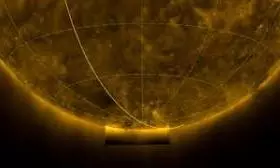
Solar Orbiter captures first-ever images of the Sun’s mysterious poles
text_fieldsIn a historic achievement for space science, the Solar Orbiter spacecraft has captured the first images of the Sun’s poles, offering scientists an unprecedented look at our star’s magnetic behavior and solar activity.
The European Space Agency (ESA), in collaboration with NASA, released the images taken in March, showcasing the Sun’s south pole during a period of heightened solar activity.
Launched in 2020 from Florida, the Solar Orbiter was designed to provide a deeper understanding of solar phenomena, including the solar magnetic field, the solar cycle, and solar wind. Until now, all solar observations were made from Earth’s orbital plane — known as the ecliptic — which limited visibility to the Sun’s equatorial regions.
To overcome this, Solar Orbiter executed a gravity assist maneuver using Venus in February, allowing it to tilt its path and observe the Sun from an angle 17 degrees below the equator. This maneuver enabled the spacecraft to capture groundbreaking images of the south pole, with data from the north pole expected to arrive in the coming weeks or months.
“The best is still to come. What we have seen is just a first quick peek,” said solar physicist Sami Solanki from Germany’s Max Planck Institute for Solar System Research, who leads the team operating the spacecraft’s Polarimetric and Helioseismic Imager instrument.
Solanki added, “The spacecraft observed both poles, first the south pole, then the north pole.”
The images reveal a chaotic magnetic environment at the poles, which scientists believe is linked to the current peak of the Sun’s 11-year solar cycle — a period when the magnetic field is preparing to reverse.
“Whilst the Earth has a clear north and south pole, the Solar Orbiter measurements show both north and south polarity magnetic fields are currently present at the south pole of the sun,” noted solar physicist Hamish Reid of University College London. “This happens during the maximum activity of the solar cycle when the sun’s magnetic field is about to flip.”
Reid also emphasised, “What we have been missing to really understand this (solar cycle) is what is actually happening at the top and bottom of the sun.”
The spacecraft is also studying the solar wind — a continuous stream of charged particles released from the Sun’s outer layers — and its role in forming the heliosphere, the massive bubble encompassing the solar system.
“The data that Solar Orbiter obtains during the coming years will help modelers in predicting the solar cycle,” Reid explained. “This is important for us on Earth because the sun’s activity causes solar flares and coronal mass ejections which can result in radio communication blackouts, destabilise our power grids, but also drive the sensational auroras.”
Though the Sun is about 93 million miles (149 million km) from Earth, its activity has a profound impact on our planet. Understanding its magnetic dynamics, especially at the poles, is essential to anticipating and mitigating the effects of space weather.
While the 1990s-era Ulysses mission also ventured over the Sun’s poles, it lacked optical instruments. “Ulysses, however, was blind in the sense that it did not carry any optical instruments — telescopes or cameras — and hence could only sense the solar wind passing the spacecraft directly, but could not image the sun,” Solanki explained.























